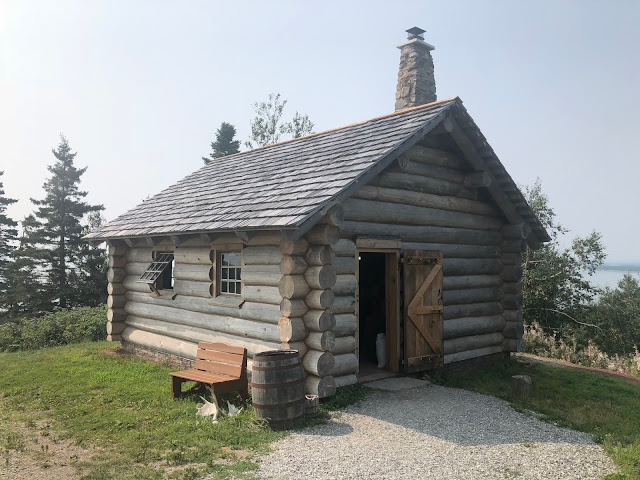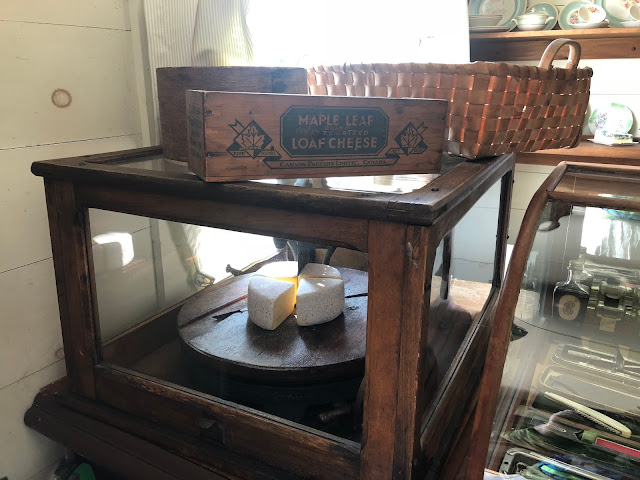It took three flights, but I made it to Halifax at midnight. A friendly young man was trying to get to town, and I offered my shuttle could take him.
He looked like a backpacker, but it turned out he was here for the conservative party of Canada's annual convention and his flight from Ottawa had been delayed, so he'd missed the keynote. This is why all the hotels were booked and super expensive. He was so excited as we drove into town: "Those are my people," he said, like a college Young Republican.When I called ahead to arrange late entry into my budget room in student housing, the kind man who took my credit card apologized there was no window. "But there's a very nice brick wall," he said, without a trace of irony. And there was.
I spent less than two waking hours in Halifax before leaving, but I did manage to hit the farmers market at the waterfront.
There's a museum of immigration I'd like to explore on another trip; Nova Scotia was the entry point for 1.5 million Europeans after World War II. That's a lot for a country of then 12 million. But Canada knows that it needs immigrants, and in recent years, they've been a model on resettling refugees.
I didn't realize Cunard of ocean liner fame was a real person. Here he is!
I spent most of the day yesterday in the car, getting out of the city. Destination: Cape Breton Island, the easternmost part of Nova Scotia and until 1949 when Newfoundland and Labrador joined, the easternmost part of Canada.
Cape Breton has strong Celtic heritage, for reasons I'll explain momentarily. Several Canadians pronounced "Gaelic" "gallic," which surprised me, but helped me realize that Breton (here pronounced BRETT-un) aka Brittany was where the Gauls came from. Maybe we should have spent less time in European History on World Wars and more on migration and geography...
Scots, who had been Catholic since the Stuarts, were harassed, and out-of-town landowners raised their rents and sometimes burned them out. Scots seeking a better life and land they could buy set off for a New Scotland: Nova Scotia.
Each of the buildings includes a display of period crafts, with a lot of attention to making yarns with natural dyes and churning butter. This first new world cottage was positively airy after the dark hut.
This is flax, as in Rumplestiltskin. Pretty sure I'd never seen it before or touched it. Flax is combed and then softened and woven into linen. The same flax flax seeds come from. The tools were quite primitive.
Of course wood is plentiful in Canada. The ships the immigrants came on arrived in the United Kingdom full of wood. They left filled with people who'd been promised land and a new life.
There were a few sheep wandering around. And a lot of spinning wheels.
This boy's wagon came from Montgomery Ward for $1.40.
I loved the colorful old tractors and threshers.
The next house was from the 1880s, and you could see the improvements in the quality of life. Better china. More established crafts. Two stories, with separate rooms for children and parents. No running water or electricity yet.
But an actual wood-burning stove, where the previous house had only an open hearth. And oil lanterns, which are much safer than candles.
This is a pipe organ. Families would have been housebound during the winter months in the 19th century. Until the 1890s, the main transport to Cape Breton was by boat to Sydney, north east of here, and then by foot or occasionally horse-drawn carriage. The bridge I took connecting Cape Breton to the mainland of Nova Scotia wasn't built until the 1950s. That's partly why the culture was preserved.
A lesson in the schoolhouse. There were also books on penmanship, the one subject I failed. Gaelic was forbidden in school until the 1920s, which may account for why there are so many songs, to preserve the language.
I don't know what Maple Leaf Loaf Cheese is: like Velveeta? This is inside the wondrous general store, packed with period goodies.
You could order boots instead of making them!
And ship off packages and trunks at this handy post office.
Tins of the dayThe optician's department...The earliest immigrants would not have been able to read or write and would have spoken Gaelic. However by the early 19th century, the Canadian government would have provided schools. A whole new world was coming to Cape Breton.
Protestants were more likely to be able to read than Catholics, because of Bible reading.
A windup Graphophone and stereoscopic photos atop the piano!
This house from the 1920s had wallpaper! In fact, with the arrival of the train, connecting Canada from coast to coast, fashion was suddenly possible. You no longer had to spin wool yourself, although the "animator" in the kitchen was still doing so.
This home was occupied by the telephone operator.
Still no running water. Is this an early commode? I'm assuming that's a laundry basket and not a basinet.
After the Highlands Village, I sped off to the Glenora Distillery for a whiskey tour. There was a ceilidh (pronounced kay-leigh) in the bar. It consisted of three young women, perhaps 16 or 17, singing beautifully and accompanying themselves on guitar, piano, and fiddle.
The best part of the tour was these giant copper vaporizers and condensers. Single malt Scotch is distilled two times. Glenora's product is highly regarded, especially the aged spirits, which they didn't offer us. But I preferred the Nova Scotia wine from Jost Vineyards that I enjoyed in the pub.
Last stop: Normaway Inn.
(Don't worry. It only looks like "Get Out.") This is a family estate with live music (a ceilidh or visit) in the library. It was built for evangelical retreats by a minister from New York City. There was even an airstrip! But he built it during the Depression and went broke. Dave's father bought it after the war.
When I checked in, Dave asked about the elections in November, and I told him I thought the Democrats would win back the House but the Senate would be close regardless. He warned me there was a Trump supporter at the Inn. I spent dinner wondering who it was : )
I feel like I've stepped back into time. It's quite a lovely valley, not far from the sea, but a world away.
The final treat of the day was Joanne, whose father was born the same year as my grandfather, here on Cape Breton, singing to an adoring crowd in Gaelic and telling us about Nova Scotia, in the library of the inn. She truly has a voice like an angel.
Tomorrow I'm off on the Cabot Trail, honoring Venetian navigator John Cabot who "discovered" tis part of the North American coast and claimed it for Great Britain.


































No comments:
Post a Comment